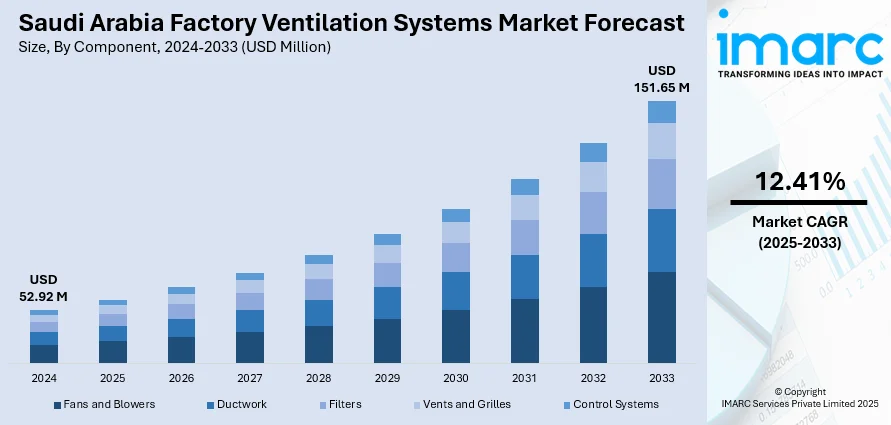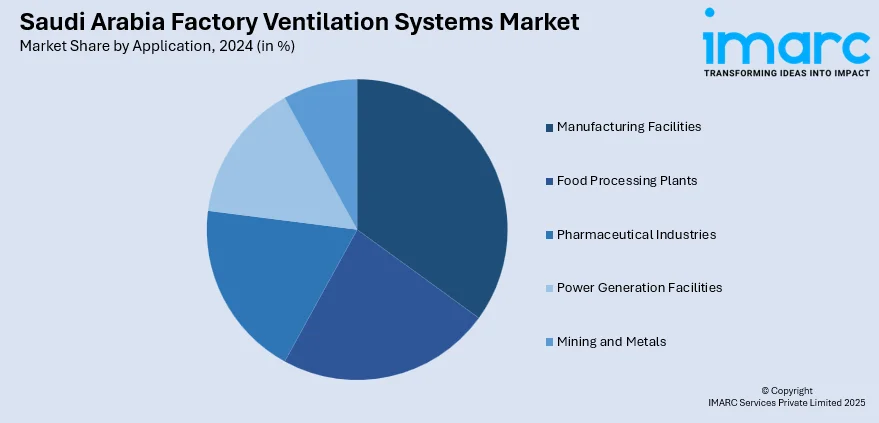
Saudi Arabia Factory Ventilation Systems Market Size, Share, Trends and Forecast by Component, Type of Ventilation System, Application, End Use Industry, and Region, 2025-2033
Saudi Arabia Factory Ventilation Systems Market Overview:
The Saudi Arabia factory ventilation systems market size reached USD 52.92 Million in 2024. Looking forward, IMARC Group expects the market to reach USD 151.65 Million by 2033, exhibiting a growth rate (CAGR) of 12.41% during 2025-2033. The market is driven by stringent industrial safety regulations, compelling factories to adopt advanced ventilation systems for compliance, while rising energy costs are accelerating demand for energy-efficient solutions. The expansion of manufacturing sectors, including automotive and food processing, further enhances the need for high-performance ventilation to maintain air quality and operational efficiency. Additionally, the growing integration of IoT and smart automation are further augmenting the Saudi Arabia factory ventilation systems market share.
|
Report Attribute
|
Key Statistics
|
|---|---|
|
Base Year
|
2024
|
|
Forecast Years
|
2025-2033
|
|
Historical Years
|
2019-2024
|
| Market Size in 2024 | USD 52.92 Million |
| Market Forecast in 2033 | USD 151.65 Million |
| Market Growth Rate 2025-2033 | 12.41% |
Saudi Arabia Factory Ventilation Systems Market Trends:
Rising Demand for Energy-Efficient Ventilation Systems
The market is experiencing a growing demand for energy-efficient solutions due to increasing energy costs and sustainability initiatives. In 2023, the total energy consumption in Saudi Arabia stayed constant at 280 Mtoe, with per capita consumption at 7.5 toe and electricity at 9.2 MWh, reflecting high energy intensity in industrial processes. While production of crude oil fell by 9% to 542 Mt, the country remains committed to absolute energy independence and has set its sights on having a 50% renewable share in its power generation by 2030. All these advances, as well as plans to cut CO₂ emissions by 278 MtCO₂eq, indicate shifting energy policies that are affecting the need for efficient factory ventilation systems in various sectors in Saudi Arabia. Factories are adopting advanced HVAC technologies, such as heat recovery ventilation (HRV) and demand-controlled ventilation (DCV), to reduce electricity consumption while maintaining optimal air quality. Government regulations, including Saudi Vision 2030’s sustainability goals, are pushing industries to minimize carbon footprints, further accelerating this trend. Additionally, manufacturers are integrating smart controls and IoT-enabled systems to monitor and adjust airflow in real time, enhancing efficiency. As industries expand, particularly in sectors including petrochemicals, manufacturing, and food processing, the need for cost-effective and eco-friendly ventilation solutions will continue to rise, driving innovation in the market.

Adoption of Smart and Automated Ventilation Technologies
Automation and smart technologies are also significantly supporting the Saudi Arabia factory ventilation systems market growth. Industrial facilities are increasingly implementing AI-driven and IoT-based ventilation systems that optimize airflow, humidity, and temperature automatically. These systems improve workplace safety, reduce operational costs, and enhance productivity by ensuring compliance with environmental standards. The growth of Industry 4.0 and smart factories in the Kingdom is further fueling this trend, as businesses seek data-driven solutions for better efficiency. Saudi Vision 2030 aligns Saudi Arabia's transformation towards Industry 4.0, with over USD 20 Billion committed to artificial intelligence by 2030. The Kingdom's National Industrial Strategy aims at modernizing 4,000 factories, focusing on automation, energy efficiency, and smart technologies, through initiatives such as "Future Factories" that improve production efficiency. Industry specialists point to the need for high-end HVAC and ventilation systems to support this digitalization of the manufacturing sector. Key players are investing in cloud-based monitoring and predictive maintenance to prevent system failures. With the government’s push for digital transformation in industries, the adoption of intelligent ventilation systems is expected to rise, making automation a dominant trend in the market.
Saudi Arabia Factory Ventilation Systems Market Segmentation:
IMARC Group provides an analysis of the key trends in each segment of the market, along with forecasts at the country and regional levels for 2025-2033. Our report has categorized the market based on component, type of ventilation system, application, and end use industry.
Component Insights:
- Fans and Blowers
- Ductwork
- Filters
- Vents and Grilles
- Control Systems
The report has provided a detailed breakup and analysis of the market based on the component. This includes fans and blowers, ductwork, filters, vents and grilles, and control systems.
Type of Ventilation System Insights:
- Natural Ventilation Systems
- Mechanical Ventilation Systems
- Hybrid Ventilation Systems
A detailed breakup and analysis of the market based on the type of ventilation system have also been provided in the report. This includes natural ventilation systems, mechanical ventilation systems, and hybrid ventilation systems.
Application Insights:

- Manufacturing Facilities
- Food Processing Plants
- Pharmaceutical Industries
- Power Generation Facilities
- Mining and Metals
The report has provided a detailed breakup and analysis of the market based on the application. This includes manufacturing facilities, food processing plants, pharmaceutical industries, power generation facilities, and mining and metals.
End Use Industry Insights:
- Manufacturing and Heavy Industries
- Food and Beverage Processing
- Pharmaceuticals and Healthcare
- Electronics and Semiconductor Plants
- Chemical and Petrochemical Industries
- Automotive and Aerospace
- Textiles and Garments
- Others
A detailed breakup and analysis of the market based on the end use industry have also been provided in the report. This includes manufacturing and heavy industries, food and beverage processing, pharmaceuticals and healthcare, electronics and semiconductor plants, chemical and petrochemical industries, automotive and aerospace, textiles and garments, and others.
Regional Insights:
- Northern and Central Region
- Western Region
- Eastern Region
- Southern Region
The report has also provided a comprehensive analysis of all the major regional markets, which include Northern and Central Region, Western Region, Eastern Region, and Southern Region.
Competitive Landscape:
The market research report has also provided a comprehensive analysis of the competitive landscape. Competitive analysis such as market structure, key player positioning, top winning strategies, competitive dashboard, and company evaluation quadrant has been covered in the report. Also, detailed profiles of all major companies have been provided.
Saudi Arabia Factory Ventilation Systems Market News:
- February 13, 2025: ROSHN and Johnson Controls Arabia signed an agreement to adopt advanced variable refrigerant flow (VRF) technology that will enhance the energy efficiency of Saudi Arabia's HVAC industry. Johnson Controls Arabia's Jeddah facility is already producing 90% of its products locally. This collaboration is part of Vision 2030's effort to encourage energy-efficient technologies and support the local industry.
Saudi Arabia Factory Ventilation Systems Market Report Coverage:
| Report Features | Details |
|---|---|
| Base Year of the Analysis | 2024 |
| Historical Period | 2019-2024 |
| Forecast Period | 2025-2033 |
| Units | Million USD |
| Scope of the Report |
Exploration of Historical Trends and Market Outlook, Industry Catalysts and Challenges, Segment-Wise Historical and Future Market Assessment:
|
| Components Covered | Fans And Blowers, Ductwork, Filters, Vents and Grilles, Control Systems |
| Type of Ventilation Systems Covered | Natural Ventilation Systems, Mechanical Ventilation Systems, Hybrid Ventilation Systems |
| Applications Covered | Manufacturing Facilities, Food Processing Plants, Pharmaceutical Industries, Power Generation Facilities, Mining and Metals |
| End Use Industries Covered | Manufacturing and Heavy Industries, Food and Beverage Processing, Pharmaceuticals and Healthcare, Electronics and Semiconductor Plants, Chemical and Petrochemical Industries, Automotive and Aerospace, Textiles and Garments, Others |
| Regions Covered | Northern and Central Region, Western Region, Eastern Region, Southern Region |
| Customization Scope | 10% Free Customization |
| Post-Sale Analyst Support | 10-12 Weeks |
| Delivery Format | PDF and Excel through Email (We can also provide the editable version of the report in PPT/Word format on special request) |
Key Questions Answered in This Report:
- How has the Saudi Arabia factory ventilation systems market performed so far and how will it perform in the coming years?
- What is the breakup of the Saudi Arabia factory ventilation systems market on the basis of component?
- What is the breakup of the Saudi Arabia factory ventilation systems market on the basis of type of ventilation system?
- What is the breakup of the Saudi Arabia factory ventilation systems market on the basis of application?
- What is the breakup of the Saudi Arabia factory ventilation systems market on the basis of end use industry?
- What is the breakup of the Saudi Arabia factory ventilation systems market on the basis of region?
- What are the various stages in the value chain of the Saudi Arabia factory ventilation systems market?
- What are the key driving factors and challenges in the Saudi Arabia factory ventilation systems market?
- What is the structure of the Saudi Arabia factory ventilation systems market and who are the key players?
- What is the degree of competition in the Saudi Arabia factory ventilation systems market?
Key Benefits for Stakeholders:
- IMARC’s industry report offers a comprehensive quantitative analysis of various market segments, historical and current market trends, market forecasts, and dynamics of the Saudi Arabia factory ventilation systems market from 2019-2033.
- The research report provides the latest information on the market drivers, challenges, and opportunities in the Saudi Arabia factory ventilation systems market.
- Porter's five forces analysis assist stakeholders in assessing the impact of new entrants, competitive rivalry, supplier power, buyer power, and the threat of substitution. It helps stakeholders to analyze the level of competition within the Saudi Arabia factory ventilation systems industry and its attractiveness.
- Competitive landscape allows stakeholders to understand their competitive environment and provides an insight into the current positions of key players in the market.
Need more help?
- Speak to our experienced analysts for insights on the current market scenarios.
- Include additional segments and countries to customize the report as per your requirement.
- Gain an unparalleled competitive advantage in your domain by understanding how to utilize the report and positively impacting your operations and revenue.
- For further assistance, please connect with our analysts.
 Request Customization
Request Customization
 Speak to an Analyst
Speak to an Analyst
 Request Brochure
Request Brochure
 Inquire Before Buying
Inquire Before Buying




.webp)




.webp)












